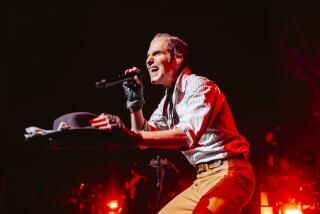Rock festivals close the age gap
- Share via
CHICAGO -- Moms push strollers through throngs of bare-chested, tattooed twentysomethings. Dads in khakis dole out fruit drinks while guys sporting mohawks and ripped jeans sip beer. And the grade-schoolers cheer as loudly as the hard-core metalheads.
Welcome to the new face of music festivals, where everyone from kids in diapers to retirees comes for the same reason: to rock out.
“I was too young for Woodstock. I didn’t really start going to concerts until my youngest son was old enough,” said Dory Schramm of Alamo, Calif., who attended this year’s Lollapalooza festival in Chicago with her husband and their 19- and 16-year-old sons, along with other family members, including 8- and 10-year-old nieces.
When it began 17 years ago, Lollapalooza was a traveling alternative music festival that drew a decidedly young crowd to hear hard rock, punk and hip-hop bands.
It has evolved into a three-day destination that features similar music and still draws young adults, but increasingly caters to all ages.
And that’s just fine with Lollapalooza founder Perry Farrell, former lead singer of the now-defunct 1990s alternative rock band Jane’s Addiction.
“I am almost 50 years old, and I certainly don’t want to be condemned. I don’t want to be looked upon as some kind of used-up dude,” said Farrell, a father of three.
“We created this scene, we deserve to be there, we belong there.”
Farrell says the festival is evolving naturally -- many of those who attended the original shows keep coming back, often with their young children in tow or tagging along with their older kids.
That might explain why there now is an entire area devoted to kids, called Kidzapalooza; this year, it included performances by such well-known rockers as Farrell, Slash from Guns N’ Roses and Jeff Tweedy from Wilco.
“I think it’s pretty remarkable that I get to see people that are below 9 showing up at our festival, and then people in their 50s showing up at our festival, and they all seem to appreciate and enjoy the music across the board,” Farrell said. “Nobody’s going, ‘Wow what the hell’s going on here?’ ”
It’s the same at other music festivals, organizers say.
The changes at Lollapalooza mirror those that already were happening at Texas’ Austin City Limits Music Festival, said Brooke Alexander, marketing manager for C3, which helps produce both festivals.
“I think our partners have always pretty much stood by the fact that we’re . . . a family festival,” she said. “Obviously Lollapalooza for the last four years hasn’t been like Lollapalooza of the early ‘90s.”
Austin -- this year’s festival is in September -- caters to an age range of 25 to 38 with more diverse food and VIP offers that price out many younger people, Alexander said, adding: “We are a company of 25 to 38 as well, and we know what we were going to want to go do if we were going to pay the money.
“Turns out, that’s who come to our festivals too.”
And then there are the kids. About 5% of those attending Lollapalooza, for example, bring their children, Alexander said.
She said the company did not market to a specific age range, “but we always keep in mind that it’s getting a little older, and that’s very interesting, especially for Lollapalooza.”
Rick Farman, co-owner of Superfly Productions, which puts on Outside Lands Music & Arts Festival in San Francisco, among others, said music festivals had always tried to draw in large audiences through diverse programming.
For example, at the Outside Lands Festival, Tom Petty will draw an older crowd. The next night, Jack Johnson will bring in younger folks.
“There’s certainly some thought that goes into how do we make the event as broad as possible,” he said.
Kristi Chuckel, marketing and public relations manager of Summerfest in Milwaukee, said that several years ago organizers began setting up a stage just for “classic rock.”
More to Read
The biggest entertainment stories
Get our big stories about Hollywood, film, television, music, arts, culture and more right in your inbox as soon as they publish.
You may occasionally receive promotional content from the Los Angeles Times.







